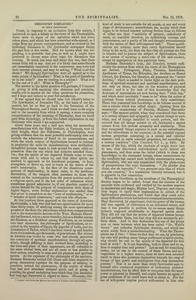
Legend
Theosophy Simplified
When, in response to an invitation from this society, I undertook to open a debate on the views of the Theosophists, there were no signs of the agitation which has since taken place, and which has been somewhat wide-spread, as I judge from my private Correspondence, and as evinced by the epistolary discussion in The Spiritualist newspaper during the past four or five weeks. Had we known what was impending, it is probable that you, as well as I, might have preferred to choose some other topic for discussion this evening. So much has been said about this one, that there seems little left to say. And yet it is likely that some friends not immediately concerned in the controversy, may have had their interest aroused, and may be asking, “What is all this about? We thought Spiritualists were all agreed as to the main points of Spiritualism? What is the good of disturbing us in our belief? Are we tending to a schism? What is to be the end of it all? What is Theosophy?”
The answer to the latter question will, perhaps, if I succeed in giving it with anything like clearness and precision, enable you to answer all the other questions for yourselves, and I hope and believe to your full satisfaction.
It was agreed that we should take Col. Olcott’s letter to The Spiritualist, of December 7th, as the basis of our discussion, but let us first go back to the formation of the Theosophical Society, and I think we shall trace in its origin and in the necessity from which it sprang, a more complete comprehension of the meaning of Theosophy, than we could gain from etymology, or from the fullest explanation in any dictionary with which I am acquainted.
About three years and a half ago, when the astounding manifestations with the Eddy brothers, in Vermont, were at their height, when the Holmeses, in Philadelphia, were giving evidence that the most powerful mediumship does not exclude the admixture of fraud in its presentations, and while the whole subject of Spiritualism seemed to increase in perplexity the more its manifestations were multiplied, thoughtful persons began to look around for some other explanation than the one which had hitherto satisfied them, viz., that the spirits of our departed friends come to commune with and to solace us, and that other spirits are enabled to approach us for beneficent purposes, to heal, strengthen, or direct us, and to teach us the lesson of the soul’s immortality. In the face of the disastrous consequences of mediumship, in many cases, to the mediums themselves, of the dangers often pursuant on those who entered on the investigation from the purest motives and in a religious spirit, and of the low order of influences which sometimes gained admission to, if not absolute control of, circles formed for the purpose of communion with those of higher degree, some further explanation was needed than that given in pamphlets on the “laws of mediumship,” or on “benefits of spirit intercourse,” and such like effusions.
At this juncture there appeared on the scene of American Spiritualism, a lady who had had rare opportunities for more than thirty years, of studying among the more spiritualised peoples of the East the phenomena which were comparatively new to the materialistic nations of the West. Madame Blavatsky had learned, not as a mere traveller, but as a dweller among the Hindoos, as a Buddhist among Buddhists, as an initiate into their mysteries, the philosophy of Spiritualism, as received in the temples of Egypt, the pagodas of India, and the Lamaseries of Thibet, where it has been stored up and handed down for hundreds, aye thousands, of generations. Her advent in America was hailed by some who had already perceived the continuity of spiritual manifestations through all ages, which, though differing in their outward form, according to the time and place of their appearance, are all referable to the same eternal laws, and are all more or less similar in their action, relatively to man and his physical and spiritual nature. As the exponent of the philosophy of the ancients, Madame Blavatsky incited Col. Olcott and other inquirers to group themselves together for the purpose of seeking to penetrate behind the phenomena, of the reality of which they had now abundant external proof, and to grasp, if possible, the grand underlying laws which they (the ancients) had long ago discovered in regard to them. Of course, this kind of study is not suitable for all minds, at any and every stage of development; nevertheless, the society which thus began to be formed exacted nothing further from its fellows of either sex than “assiduity of purpose, catholicity of mind, an unselfish devotion, an unflinching courage and perseverance, and a purity of life and thought commensurate with the nature of their self-imposed task.” These qualifications are nothing more than every Spiritualist should bring to his work, yet from the fact that all persons are free to inquire, and to pursue the subject of Spiritualism, there is no means of securing a strict rule of life and conduct, except by segregation on this particular basis.
Madame Blavatsky’s book, Isis Unveiled) reveals sufficiently the sources from which the views of the Theosophists are derived. Pythagoras, Plato, Plotinus, lamblichus, Apollonius of Tyana, the Ebionites, the dwellers on Mount Carmel, the Essenes, the Gnostics, all possessed the “secret doctrine,” which is needed to throw light on the dark problems of spiritual existence and spiritual manifestation, and not only on these, but also on the wonders of physical science; and it is for lack of this knowledge that the doctrines of materialism are now having their “little day,” and which must inevitably u cease to be” when the action of spiritual forces behind phenomena is fully established. Those who possessed this knowledge in its fulness erected it into a science which was called magic. Quoting from the manuscript commentary of Proclus, Madame Blavatsky says: “The ancient priests, when they considered that there is a certain alliance and sympathy in natural things to each other, and of things manifest to occult powers, and discovered that all things subsist in all, fabricated a sacred science from this mutual sympathy and similarity. Thus they recognised things supreme in such as are subordinate, and the subordinate in the supreme; in the celestial regions terrene properties subsisting in a causal and celestial manner; and in earth celestial properties, but according to a terrene condition” {Isis Unveiled) Vol I., p. 243). By means of the key, which the students of magic knew how to use, they discovered individualised spirit behind all phenomena, and thus arose the belief (which to them was knowledge) in the elemental beings, whose resuscitation by the occultists has caused such terrible consternation among Spiritualists, who are only acquainted with the phenomena of presentations like unto themselves. “Du gleichst dem, Geist, den du begreifst;” “you perceive only that of which you can conceive,” is a translation literally reversed, but it is apposite in this connection.
When the Occultists, as the members of the Theosophical Society began to be called, found that the theories of the ancients were confirmed and verified by the modern masters in mesmerism and magic, Eliphas Levi, Dupotet, and others, they began to apply their explanations to certain of the Spiritualistic phenomena, and found that they could solve many difficulties which had hitherto remained insurmountable. They discovered, by experiment, that the power of the human will was capable of cultivation to an unlimited extent, and that it was possible to perform by its means many things hitherto supposed attributable to departed spirits alone. They did not say that the spirits of departed human beings did not perform them, but that they did not necessarily perform them. And in this distinction lies one of the points now at issue between what has been called “Dr. Wyld’s theory” and orthodox Spiritualist doctrine, and which has arisen solely from a misunderstanding. What the Theosophists say is this: “Since we find that we can, by practicing our own will produce many things performed at spirit-circles, why should we call in the spirits of the departed for this kind of work? Is it not degrading, both to them and to us, thus to employ time and powers? Let us seek for something better, let us rise to the control of these forces, and seek inspiration in a higher source, since we have seen mischief result to those who prostrate themselves beneath the sway of beings of less power and intelligence than they themselves possess.” This is no more than every Spiritualist says to himself after continued experience of elementary physical manifestations, but he often fails to recognise that the same power is inherent in himself, and might become an agent of great usefulness if he could learn how to direct it. For the use of will-power implies perfect self-control in him who <... continues on page 4-213 >
* A paper read before the Dalston Association of Inquirers into Spiritualism.
Editor's notes
- ↑ Theosophy Simplified by Kislingbury, Emily, London Spiritualist, No. 286, February 15, 1878, pp. 76-7
-
London Spiritualist, No. 286, February 15, 1878, pp. 76-7

